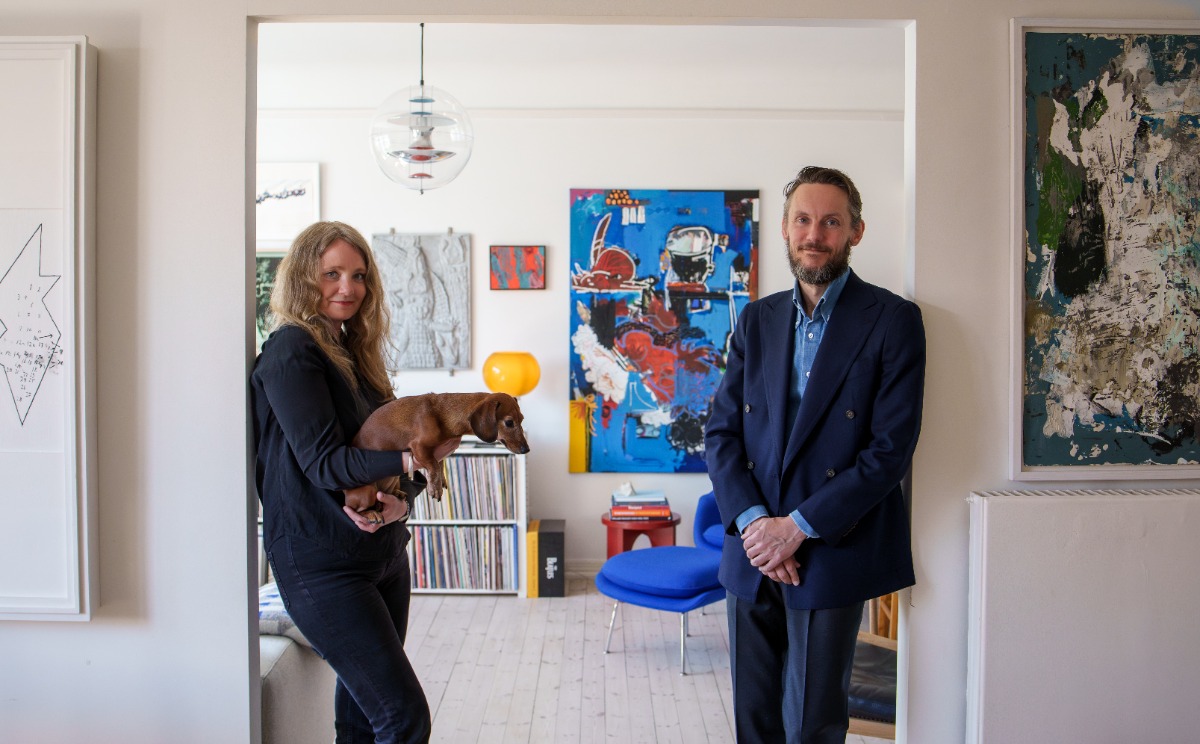
Collecting Art: A Couple Goal
A conversation with Norwegian Art Collectors Tord Rønning Krogtoft and Mari Indregard
Oslo-based art-collecting couple Tord Rønning Krogtoft and Mari Indregard are deeply devoted to both each other and the arts, and eloquently articulate their shared dedication to the continual growth of their collection: “We don’t go on expensive holidays. Our summers are spent in an old schoolhouse nestled in a small fjord, where we enjoy eating the fish we catch from the sea. We simply chose to invest in art.” While both savour the ‘friluftsliv’ (a simple life in nature without destroying or disturbing it) in the diverse and often rugged landscape of Northern Europe, it subtly influences their preference for art that exudes softness and calm rather than provocation. The Krogtoft/Indregard art collection comprises modern and contemporary pieces by established and emerging Norwegian visual artists, with an emphasis on supporting female professionals from the region. Their approach to collecting, almost as if it were an approach to capturing and preserving moments in their lives, transcends the mere hoarder’s thrill of acquiring something new. Culture, aesthetics, and visual art have always been central to Krogtoft and Indregard, both personally and professionally. Until recently, Tord Rønning Krogtoft served as the Director of Business and Marketing at the newly opened National Museum of Art, Architecture, and Design in Oslo. Alongside a team of creative minds from the museum, he played a pivotal role in bringing art home (literally and figuratively) to the Norwegian people, despite years-long delays in the museum’s reopening that have kept Munch’s The Scream and other significant national treasures out of public view. Additionally, Krogtoft holds positions as a board member of Carte Blanche (the Norwegian national company of contemporary dance), Oslo Jazz Festival, and Oslo Open – open studio weekend in April. His partner, Mari Indregard, who holds a master’s degree in art history and started acquiring art as young as 18, is the mind and sparkling spirit behind the couple’s private art world. With a mischievous twinkle in their eyes and contagious laughter, they ecstatically recount their art-collecting journey in the conversation with Arterritory.
(from left to right) works by Knut Rumohr, Håkon Gullvåg, Jens Johannessen, Eilif Amundsen, Ann Iren Buan, Andreas Siqueland, Linn Pedersen, Even Bie-Larsen ©Thomas Hartvig Olesen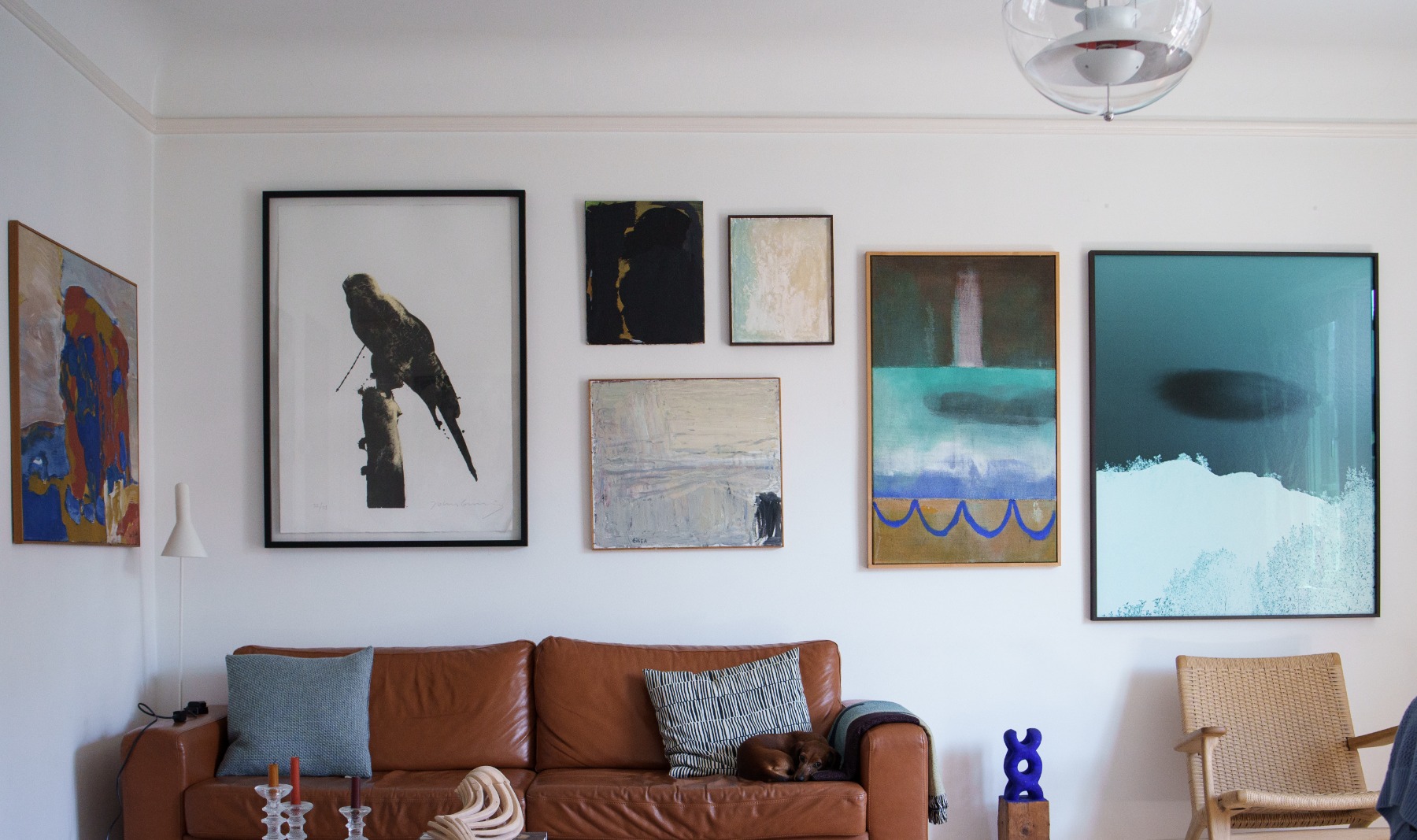
No one forgets their first art purchase. How did your journey as an art collector begin?
Mari: I bought my first artwork when I was 18 years old, in 1995, at a small Prague gallery. I was Interrailing across Europe with a friend of mine. Towards the end of our travels, we had some money left, and we decided that if we saved on food, we could afford to bring home some artwork. We acquired two prints from the same artist, though mine currently is in the attic. I gradually grew weary of its presence. The print portrays the fusion of a woman’s body with the head of a fish.
Tord: Mari has a master’s in art history, so she’s the brains behind our art acquisitions. I’m just a hoarder with really good taste. Hah! I have too many men’s suits and shoes, but I also collect books, music records, and art.
Mari: The very first art piece that Tord acquired for me was a photograph by Grethe Irene Einarsen.
Photography by Grethe Irene Einarsen ©Thomas Hartvig Olesen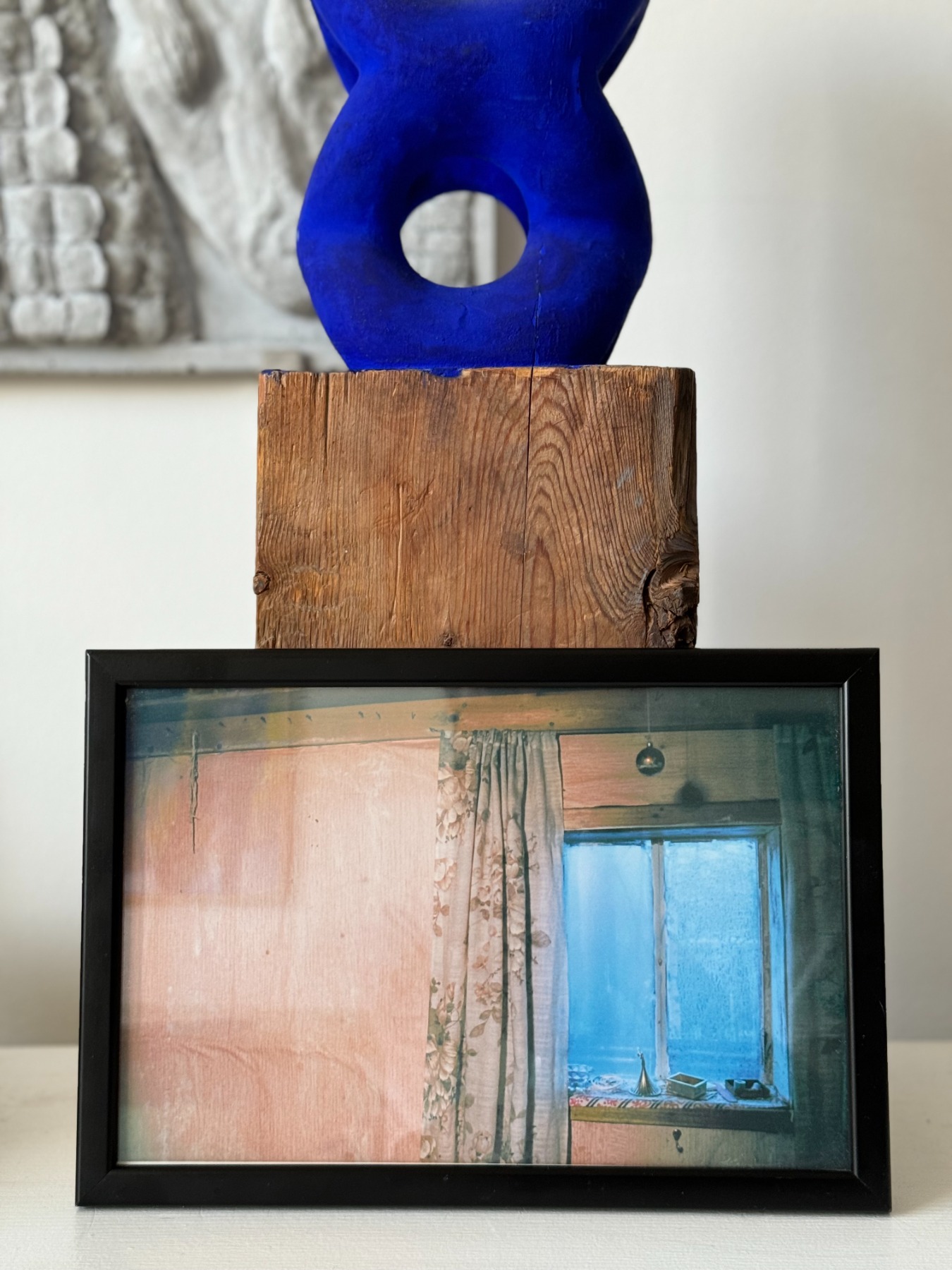
Could you briefly describe your art collection? Do you actively seek out underrepresented voices in your collection?
Tord: Our collecting approach isn’t highly strategic; it’s always about our love for a particular artwork, with no investment motives. It would be a stretch to say that we actively seek out underrepresented voices in our collection. However, a crucial aspect of our collecting is our preference for acquiring works by young, female, and living artists, preferably directly from the artist or their representing gallery. Given the historical underrepresentation of female artists in museums worldwide, our collection invests in such voices. Nonetheless, this isn’t a strict rule; we also have many deceased Norwegian artists represented in our collection. However, by focusing on living Norwegian artists, we contribute in a small way to the local art scene.
Sometimes it requires a significant investment. Since we don’t have children, we have more opportunities to buy art than most people in our age group, so we prioritize it. We don’t go on expensive holidays. Except for visiting good friends in New York this spring. Our summers are spent in an old schoolhouse nestled in a small fjord, where we enjoy eating the fish we catch from the sea. We simply chose to invest most of our income in art.
Tord's morning dive in Oslo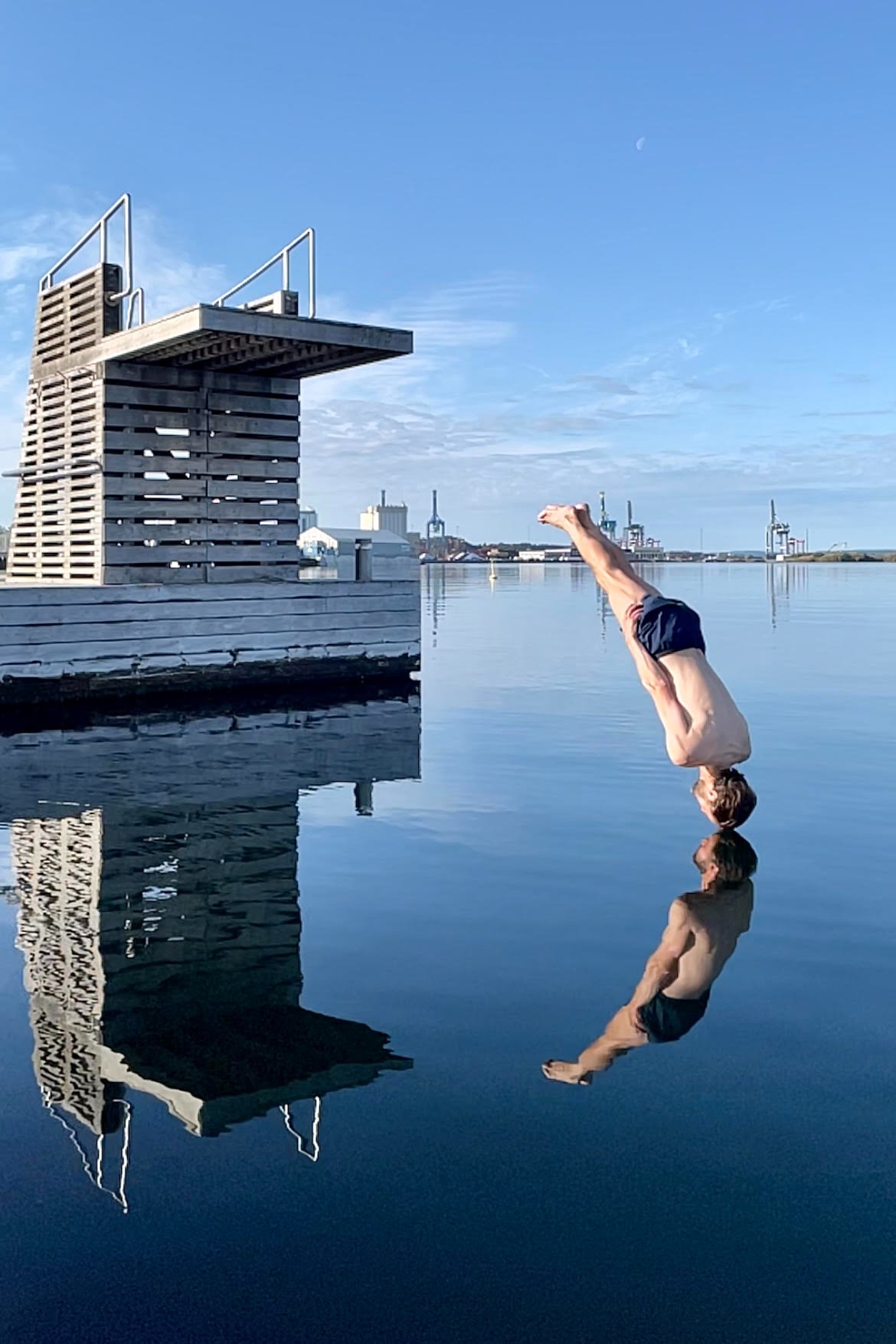
Norway is renowned for its stunning natural landscapes, and living near the sea can have a profound impact on how you perceive the world. And do you think it has influenced your taste in art?
Mari: I believe that hailing from the northern part of Norway, where we’re surrounded by dramatic nature such as mountains and fjords, we don’t feel the need to collect much landscape art because we experience nature firsthand in our surroundings. Instead, we seek tranquility in our home and gravitate towards artworks that exude calmness. You won’t find much provocative or dramatic art in our collection. However, we do have two landscape paintings depicting the northern part of Norway that I inherited from my grandmother. They hang nicely in the kitchen, and I cherish them dearly, although I wouldn’t have purchased them myself.
Tord: While living by the sea may not have greatly influenced our collecting habits, it undoubtedly has a profound impact on us as humans. I start my mornings with a run down to the sea and a swim, regardless of the season. The light in the morning by the sea, especially in March, April, and May, is unparalleled.
Work by Ann Iren Buan ©Thomas Hartvig Olesen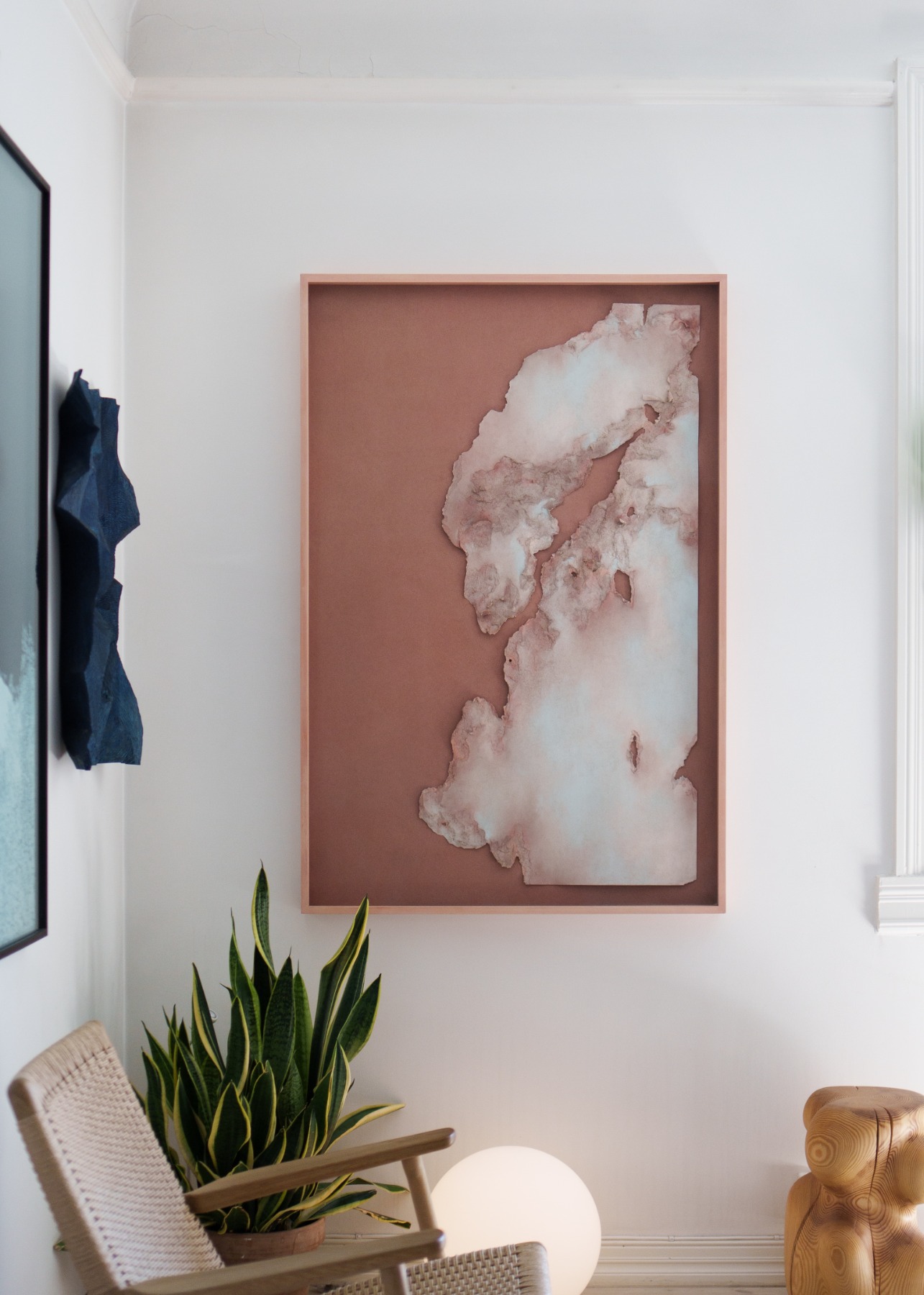
Is it possible to have a favorite artwork within a collection?
Mari: Yes, Tord can tell the story behind it; it’s quite a long one.
Tord: Mari and I have long been fans of works by Ann Iren Buan. Most of her pieces are of institutional size, and she is represented in many of the major Norwegian collections, both private and in art institutions. However, she rarely creates works in a size suitable for a regular living room. Despite this, we managed to acquire a small piece of hers.
Every year, Oslo Open takes place, which is an open studio weekend in the city. Last year, we visited Ann Iren Buan’s atelier. On the wall, she had some pieces she was currently working on. We had a conversation with her and then left the studio. However, Mari couldn’t stop thinking about one particular piece she had seen there. She mentioned contacting the gallery to see if there were any available works.
Mari’s birthday was approaching, and last year marked our 25th anniversary as a couple. So, I decided to make her birthday extra special. I reached out to Ann Iren directly on Instagram and asked if there were any works she could sell without Mari knowing. The artist was receptive and agreed to complete the work Mari had admired in her studio. We made an arrangement that if Mari contacted her, she would simply say that there were no available works. I also gave the same instructions to her representing gallery in Oslo. At one point, we even visited the gallery to inquire about available works, and the gallerist had to lie to Mari.
On her birthday at 11 o’clock, I picked up the artwork from the framers outside of Oslo and mounted it on the wall in our home.
I knew that when she comes home, she follows her usual trajectory: from the hallway to the bathroom, swinging by the kitchen. So, as she arrived from work, explaining her day with much chatter – this and that, blah blah blah – I quietly trailed behind her. When she entered the living room, her eye caught something different, and she then froze.
Mari: I saw Ann Iren Buans’ work in front of me, and then I began to cry.
Mari Indregard in front of the work by Ann Iren Buan ©Thomas Hartvig Olesen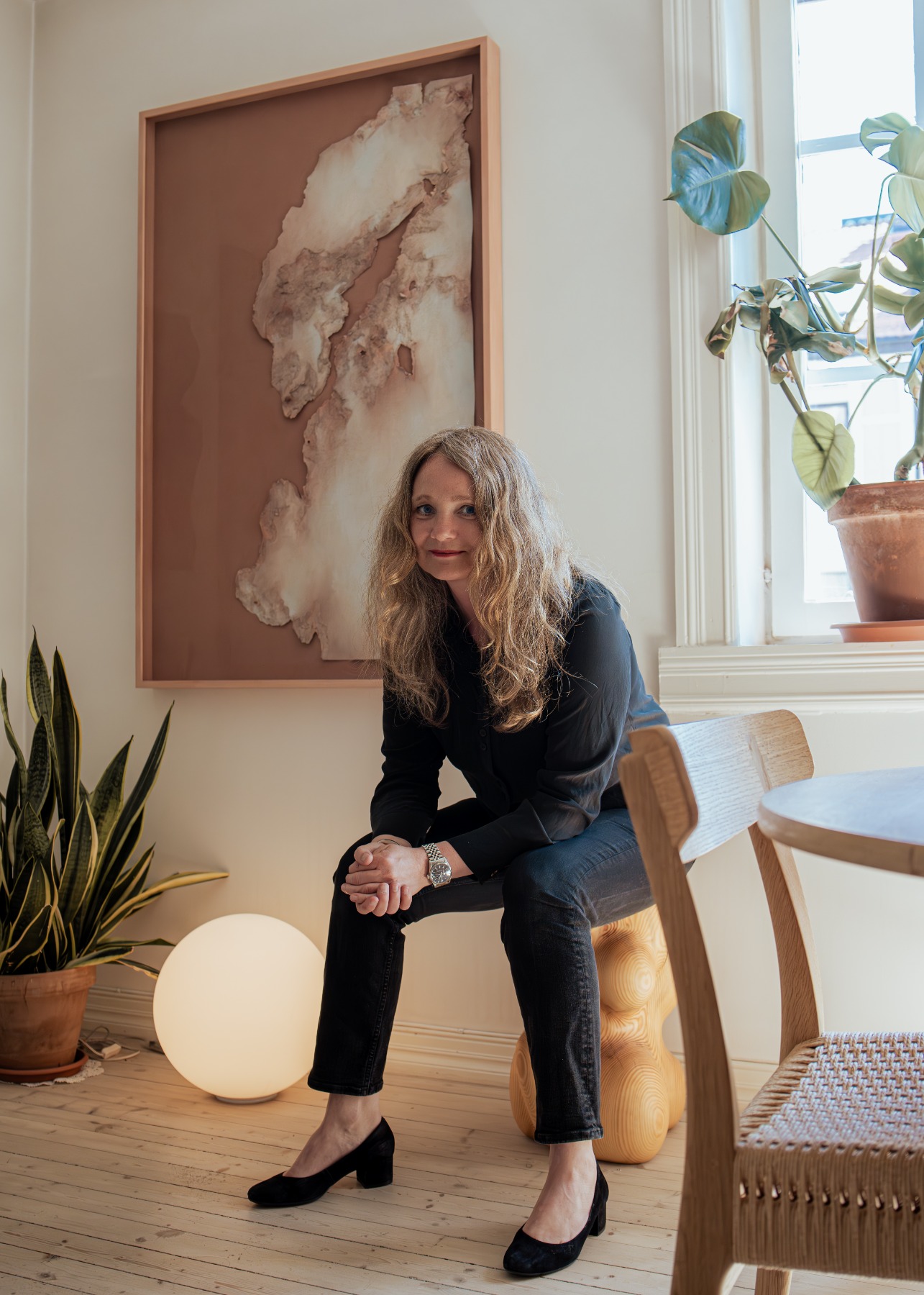
Mari, he’s a keeper. I understand why this piece is so special to you. But could you tell me what grabbed your attention about this particular artwork in the first place?
Mari: What captures me is her technique – how she manipulates paper. It’s just something I haven’t seen before. Paper as a material is fragile, yet there’s still strength in it. So it’s that combination, along with her use of colors really captivates me. Her work isn’t pre-mediated; it evolves in the process. Ann Iren Buan is going to have two exhibitions at the gallery OSL Contemporary and the Kunstnerforbundet (a gallery run by artists in Oslo) this year, and we’re looking forward to it.
Leonard Rickhard, «Innflyvning over stort dukkehus». 2013-2014 ©Thomas Hartvig Olesen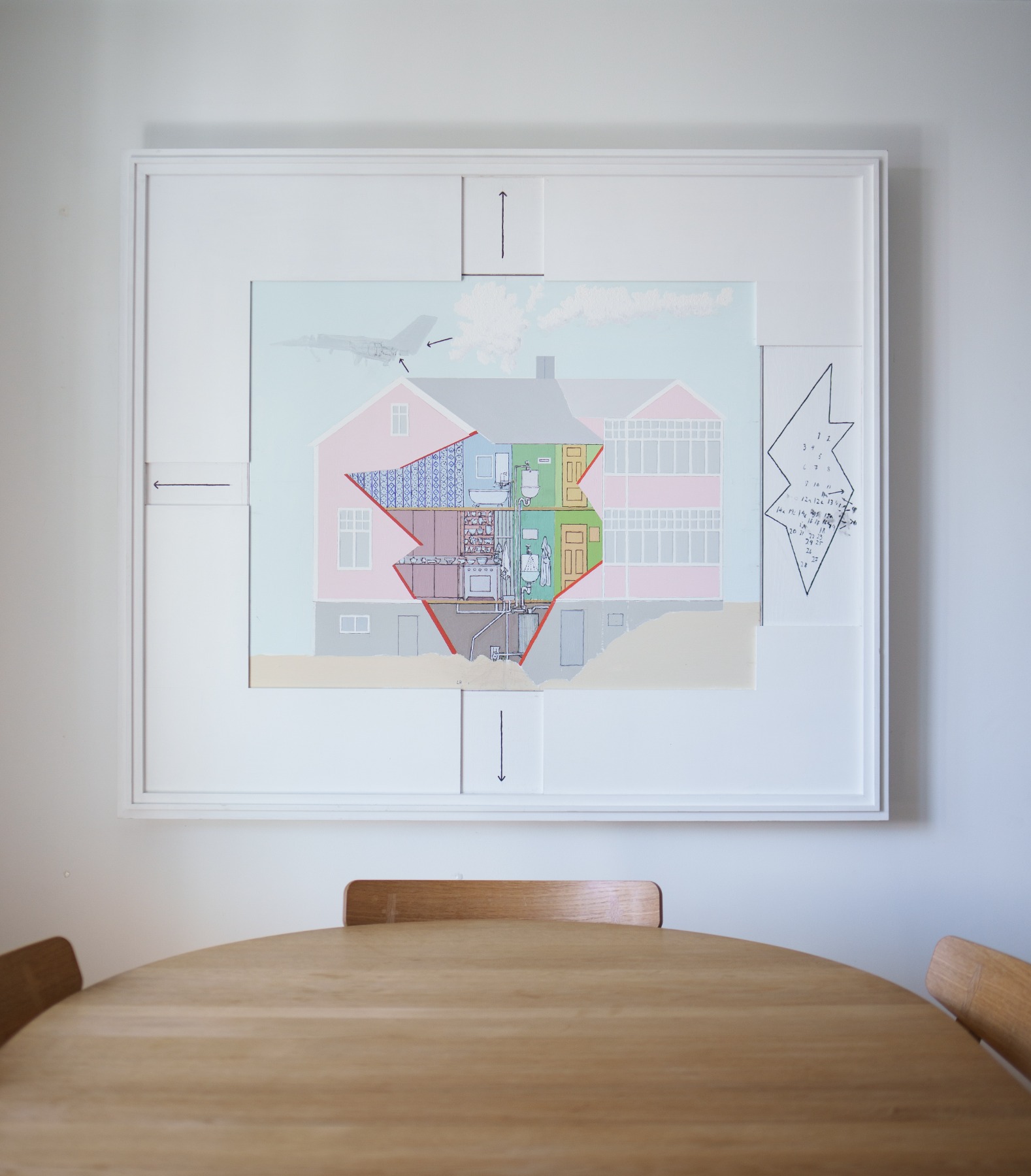
Which artwork seems to attract the most attention from your guests?
Mari: The one that people stop and are curious about is the conceptual Norwegian painter Leonard Rickard’s ‘Doll House’ (2013/2014), a piece we were fortunate to acquire some years ago. Currently, there is a great retrospective exhibition titled ‘Between Construction and Collapse’ at the Astrup Fearnley Museum in Oslo. Unfortunately, he passed away on the 7th of January, just one week before the exhibition opened. His death came as a shock to the art world, and Norway lost one of its foremost artists.
Many of his motifs and figures stem from the artist’s childhood in the immediate aftermath of World War II and can be traced back to the nineteen-seventies. Perhaps his most familiar motifs include plane models, building sites, and machines, evoking a nostalgic touch of growing up in another time. His choice of hues is unique: not dramatic, but soft and light, imparting a silent feeling to his works
Jardar Lunde, «Lofotfiske», 1944. ©Thomas Hartvig Olesen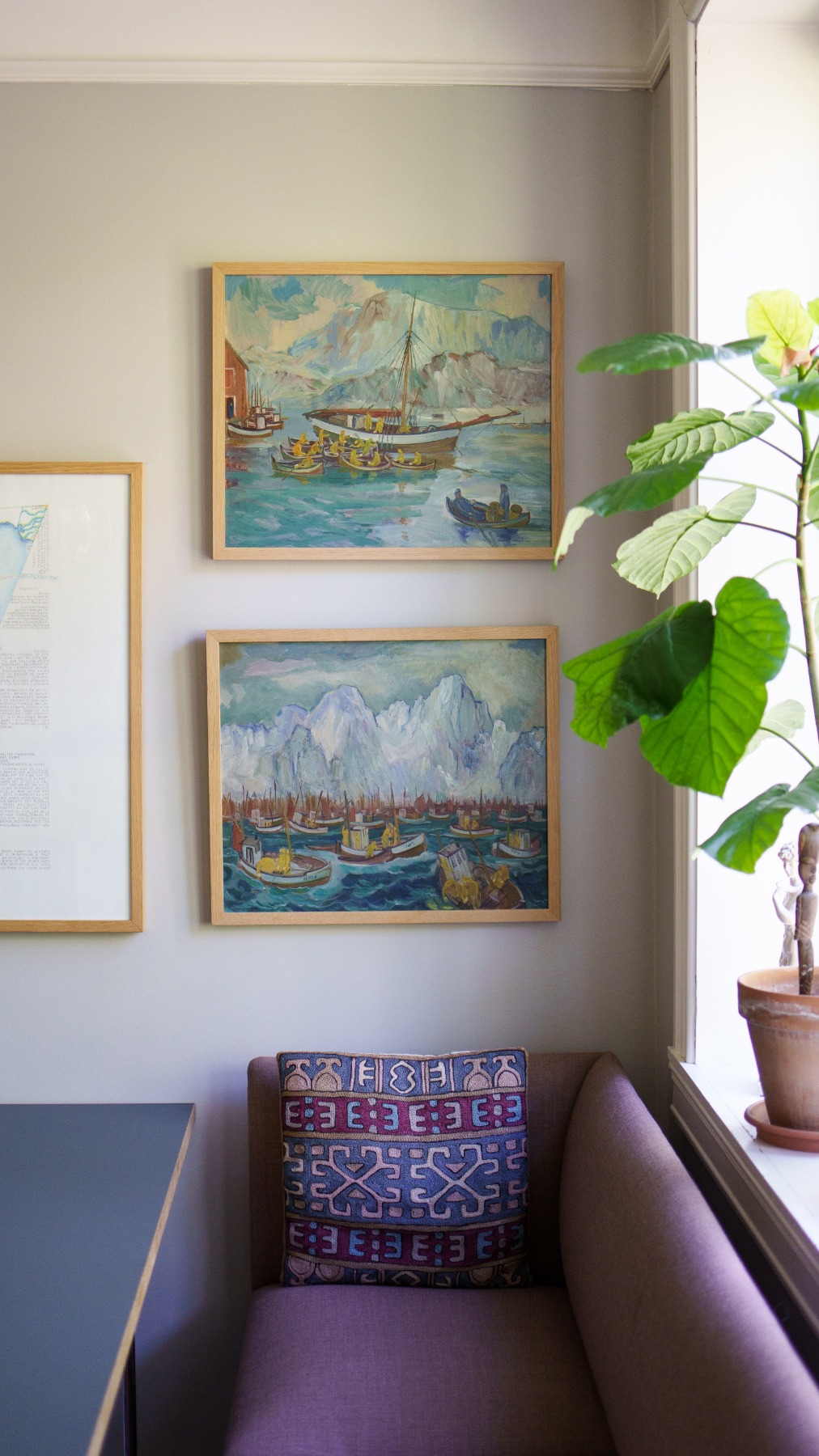
Tord, you previously held the role of Director of Marketing and Business at the National Museum in Oslo. How did you envision bringing the museum’s collection closer to the public?
Tord: I was as director of Business and Marketing from 2018 until March 2024. The new National Museum was initially scheduled to open in the fall of 2019 but ended up opening in 2022 due to delays in the building project. During this time, public criticism arose regarding the museum’s closure and the inaccessibility of its collection, which we had to address.
An excellent collaboration developed between art historians at the museum and the marketing department. National Museum decided to send a number of the collection’s key works to places where they have a local affiliation, either through being created there, through the motif or through the artist’s ties to the place. It totalled in 36 various locations and venues around the country, from the south to the northernmost part of continental Europe. Besides local museum spaces, the collection travelled to Hå Refugee Centre, Halden prison, an elderly home in Narvik, and an old church in Finnmark. One of the works on the tour was also the ‘Bridal Procession on the Hardangerfjord’ (1848) by Adolph Tidemand and Hans Gude, a prominent example of national romanticism.
Hans Gude, Adolph Tidemand, «Bridal Procession on the Hardangerfjord», 1848. Photo: Nasjonalmuseet Børre Høstland
I wasn’t expecting such efforts – physically bringing art to the people. I imagined you working against the algorithms and creating a slow-motion Instagram video of what happens in the night at the museum...’ or something of that sort of campaign.
Tord: The story gets even better.
An elderly lady, named Else, living just outside Narvik, a rather remote town where Mari and I are originally from too, expressed her admiration for ‘Bridal Procession on the Hardangerfjord’ on the museum’s Facebook page. She mentioned her health prevented her from travelling to Oslo to see it. In line with the National Museum’s mission to make art accessible to all, we made an impromptu decision to ensure she could see it. Although the work had already travelled further north, we made a detour through Narvik on our way back to Oslo. Wanting to keep it a surprise, my stepmother, who knew a friend of hers, arranged for this lady to stay home under the pretence of a coffee gathering with friends. When we arrived, we set up a personal viewing of the artwork in her backyard, introduced ourselves, and explained why we were there. She was overjoyed and in tears. There’s a video and additional material on the National Museum’s webpage.
National Museum’ s Aaward-winning ‘Art is Coming Home’ (Kunsten kommer hjem) campaign
That’s such a touching story.
Tord: I still get goosebumps whenever I tell this story. We initially hoped to hang the painting on her wall. We even attempted to obtain architectural drawings to see if we could install the most famous Norwegian painting in her home.
Mari: The most famous painting is ‘The Scream’ by Edvard Munch.
Tord: Well, it would have been the second most important work from the national art collection to hang in her home, but the available wall space was too small, so we displayed it in her garden.
Do museums struggle to promote their purpose? How can classical fine art and exhibitions be promoted in an era dominated by overwhelming digital content, where the competition of convincing someone in just 15 seconds is crucial?
Tord: This is a really big question and one of the most interesting ones for me as a former director of business and marketing at the National Museum. I’d be more than happy to discuss this at greater length. For the sake of brevity, I will begin by disagreeing with the premise of your question. Art, whether fine or not, should neither compete with nor need to stand out compared to other cultural forms or expressions. The distinction between ‘high’ and ‘low’ culture always depends on the eye of the beholder. What one person considers high art might be seen as low by another.
In my opinion, the competition is more about time than money; how we choose to spend our spare time is crucial. Whether we watch Netflix at home or go to see an exhibition. It’s not about the competition between different forms of culture. Social media, particularly Instagram, has helped the visual arts to some degree by exposing more people to art than before. However, art must be experienced in real life, not just on a small screen. This is what should be promoted as a museum’s biggest advantage: the experience belongs on the wall, for each of us to see in person.
That being said, our campaign before the National Museum opened was “a small screen solution to a real-life experience” for everyone except the few who got to experience the works in real life. As someone working in marketing, I strive for the “best of both worlds,” a concept that isn’t always possible.
Rina Charlott Lindgren, «Uten tittel XVII», 2022. © Øystein Thorvaldsen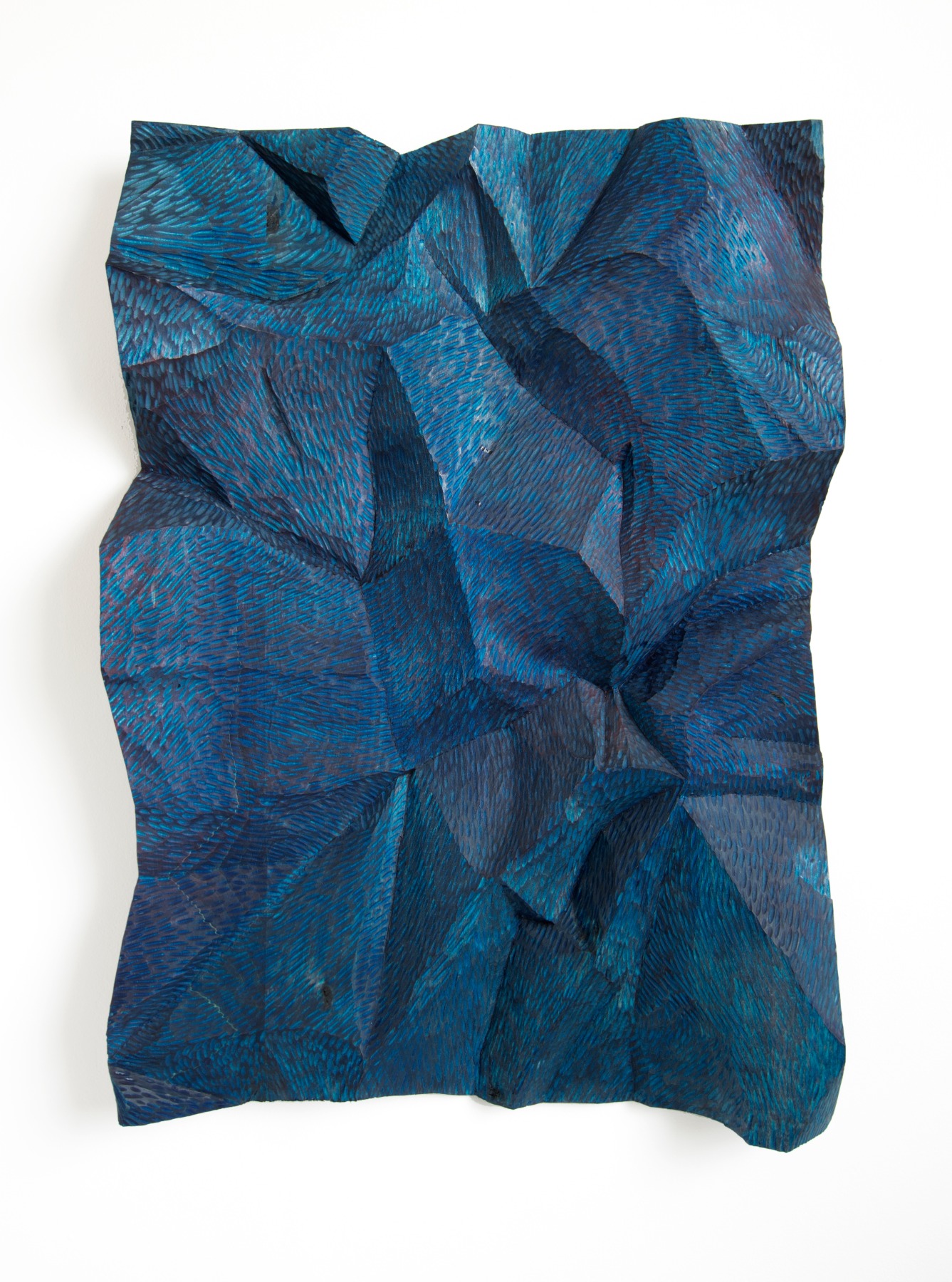
What tangible and intangible legacies does art leave behind?
Tord: Answering this question is both challenging and straightforward. The tangible legacy of art is evident in museums and galleries worldwide, where we can look at (although often not touch) artworks spanning from ancient times to the present day.
Curators put works together I ways that can give us a new understanding of the art. This is an intangible element that the museums also bring to us, and work with every day, thus covering the whole spectrum of tangible/intangible. The easier answer is, that art can make us feel much more than most other things: Mari´s feelings of joy when seeing Ann Iren Buan’s work on our living room wall, or Else’s emotions when we presented “Bridal Procession on the Hardangerfjord” for her in her garden are both in their way perfect examples of the intangible legacy of art and how it can profoundly touch us.
Wendimagegn Belete, «uten tittel», 2018. ©Thomas Hartvig Olesen
Do you have any anecdotes or adventures related to your journey as art collectors?
Mari: I don’t think Tord agreed when I bought this primitive wooden duck by Norwegian printmaker, sculptor, and glassmaker Arne Lindaas. I got it from Blomqvist Auctions. Usually, I always research the pieces before bidding on them. But this time, I decided to just get it. Turns out, I was the only one bidding on it. The head of the duck was a bit covered up with bubble wrap, and I had it on my lap during the 20-minute bus ride home. As I sat on the bus, I thought I had done well. Haha!
Tord: We only regret not buying an artwork. We never regret buying an artwork.
What would be your advice for somebody who wants to start to collect?
Tord: Before joining the new National Museum, I spent two decades in the music/festival business. Questions frequently arose about the essence of music and what constitutes ‘good’ music. Yet, the beauty of music, like art, lies in its subjectivity. If you find something groovy, there’s no need for further justification. If an artwork resonates with you, that’s enough. People tend to overthink, but collecting art shouldn’t be more complicated than that.
Mari: I believe it’s important to regularly visit galleries and museums and see as much art as possible. When we were growing up in Narvik in the early ‘90s, there weren’t many galleries or museums around. However, nowadays, you should make an effort to explore them. Additionally, pay attention to public art in every town and city.
Mari and Tord Rønning, and Sonja the dog ©Thomas Hartvig Olesen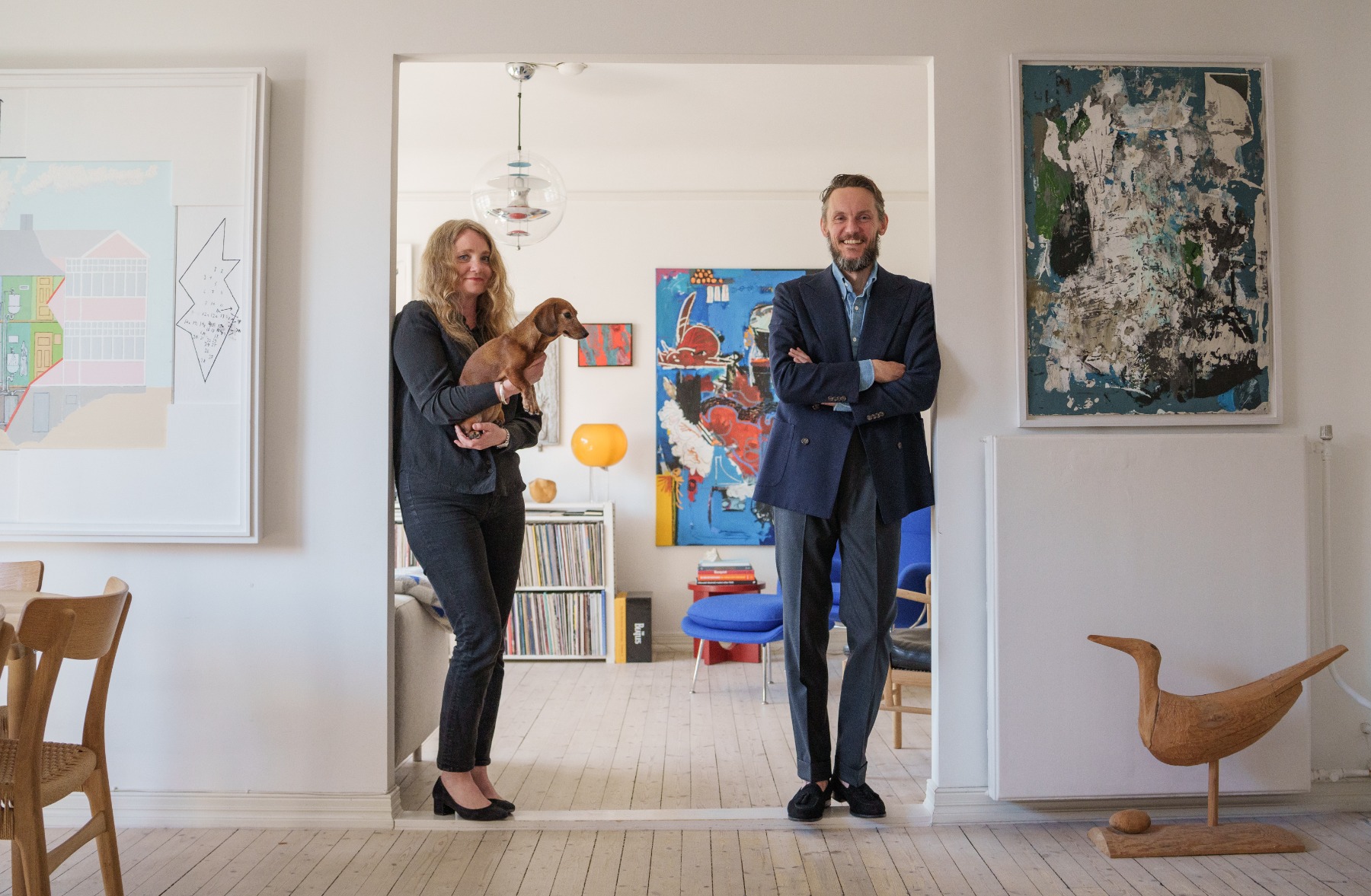
What are you looking forward to in the Norwegian art world this year?
Tord: We eagerly anticipate the opening of several new museums and cultural quarters, positioning Norway as an exciting destination for arts and culture in Northern Europe. One such development is the Kunstsilo Art Museum, which opened this May in Kristiansand, Southern Norway, with the Tangen Collection as its centerpiece. Additionally, further north in Trondheim, the new Nye Hjorten Teater & Posten Modern Museum will open its doors this year. But the best thing is visiting our local galleries and museums in Oslo each week. There is so much great stuff happening, and so much art to discover and experience. We feel lucky to live in Oslo!